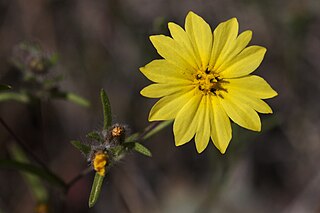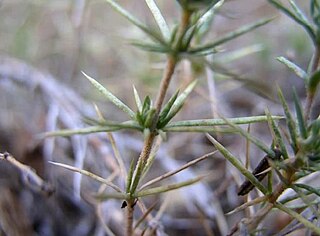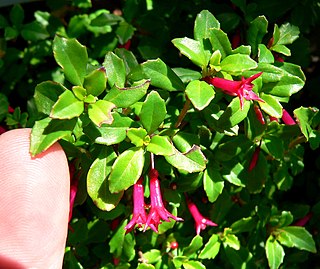
Pinguicula moranensis is a perennial rosette-forming insectivorous herb in the flowering plant family Lentibulariaceae. It is native to El Salvador, Guatemala, Honduras and Mexico. A species of butterwort, it forms summer rosettes of flat, succulent leaves up to 10 centimeters (4 in) long, which are covered in mucilaginous (sticky) glands that attract, trap, and digest arthropod prey. Nutrients derived from the prey are used to supplement the nutrient-poor substrate that the plant grows in. In the winter the plant forms a non-carnivorous rosette of small, fleshy leaves that conserves energy while food and moisture supplies are low. Single pink, purple, or violet flowers appear twice a year on upright stalks up to 25 centimeters long.

Thunbergia alata, commonly called black-eyed Susan vine, is a herbaceous perennial climbing plant species in the family Acanthaceae. It is native to Eastern Africa, and has been naturalized in other parts of the world.

Acanthomintha duttonii is a species of annual plant endemic to San Mateo County, California in the family Lamiaceae. It is commonly called San Mateo thornmint and is found growing on serpentine soils near the Crystal Springs Reservoir in a six-mile (10 km) long strip on the east side of Montara Mountain at elevations of approximately 150 to 300 meters.

Allium tuolumnense is a rare species of wild onion, known by the common name Rawhide Hill onion.

Lagophylla minor is a species of flowering plant in the family Asteraceae known by the common name lesser hareleaf. It is endemic to California, where it grows in the foothills surrounding the Sacramento Valley. It is a member of the plant communities growing on serpentine soils. This is an annual herb producing a thin, forking, purplish brown stem covered in small stiff hairs. The hairy leaves are 2 to 5 centimeters long and linear in shape, those on the lower stem toothed and those on the upper smooth-edged. The inflorescence bears flower heads with five bright yellow three-lobed ray florets, six yellow disc florets with black anthers, and phyllaries with long, soft hairs. The fruit is a glossy black achene two to three millimeters long.

Atriplex lentiformis is a species of saltbush.
Collinsia greenei is a species of flowering plant in the plantain family known by the common name Greene's blue-eyed Mary.
Epilobium rigidum is an uncommon species of flowering plant in the evening primrose family known by the common names stiff willowherb and Siskiyou Mountains willowherb.

Peteria thompsoniae is a species of flowering plant in the legume family known by the common names spine-noded milkvetch and Thompson's peteria. It is native to the western United States, where it grows in salt desert shrublands in soils of volcanic ash origin, and in alluvial fans. It is a spiny perennial herb growing from a taproot and rhizome system, its stem growing 20 to 60 centimeters tall. The leaves are made up of several pairs of oval leaflets. The inflorescence, a spikelike raceme at the top of the stem, produces white or pinkish pealike flowers up to 2.5 centimeters long, its base encapsulated in a tubular calyx of glandular sepals. The fruit is a leathery, slightly inflated legume pod up to 6 centimeters long.

Triteleia montana is a monocot flowering plant in the genus Triteleia. Its common names include Sierra triteleia, and mountain triteleia. It is endemic to California, where it is limited to the Sierra Nevada. It occurs in coniferous forests on granite soils. The Latin specific epithet montana refers to mountains or coming from mountains. It is a perennial wildflower growing from a corm. There are two or three basal leaves measuring up to 30 centimeters long and just a few millimeters wide. The inflorescence arises on an erect, rough-haired stem up to 25 or 30 centimeters tall. It is an umbel-like cluster of several flowers each borne on a pedicel up to 3 centimeters long. The flower is yellow with a dark midvein, and dries purplish. The funnel-shaped corolla is made up of six tepals up to a centimeter long each. There are six stamens with white or blue anthers.

Polygala lewtonii is a rare species of flowering plant in the milkwort family known by the common name Lewton's polygala, or Lewton's milkwort. It is endemic to Florida in the United States, where it is limited to the central ridge of the peninsula. There are about 49 occurrences of the plant remaining. Most occurrences contain very few plants. The species is threatened by the loss and degradation of its habitat. This is a federally listed endangered species of the United States.
Sanicula mariversa is a rare species of flowering plant in the family Apiaceae known by the common name Waianae Range black-snakeroot. It is endemic to Hawaii, where it is known only from the Waianae Mountains on the island of Oahu. It is threatened by the degradation of its habitat. It is a federally listed endangered species of the United States.
Erythronium elegans is a rare species of flowering plant in the lily family known by the common names Coast Range fawnlily and elegant fawnlily. It is endemic to Oregon in the United States, where it is known from about 12 occurrences in the northern Coast Range.
Agave phillipsiana is a rare species of flowering plant in the asparagus family known by the common names Grand Canyon century plant and Phillips agave. It is endemic to Arizona in the United States, where it lives only in Grand Canyon National Park. It is a perennial herb or shrub.

Nothoscordum bivalve is a species of flowering plant in the Amaryllidaceae known by the common names crowpoison and false garlic. It is native to the eastern United States from Texas to Florida up to Nebraska and Ohio, as well as Mexico, Peru, Uruguay, northeastern Argentina and central Chile.

Linanthus watsonii is a species of flowering plant in the phlox family known by the common name Watson's prickly phlox. It is native to the western United States, where it occurs in Colorado, Idaho, Nevada, Utah, and Wyoming.

Penstemon eriantherus is a species of flowering plant in the plantain family known by the common names fuzzytongue penstemon and crested beardtongue. It is native to western North America, where it occurs in western Canada and the northwestern and north-central United States.

Alysicarpus vaginalis is a species of flowering plant in the legume family, Fabaceae. It is native to parts of Africa and Asia, and it has been introduced to other continents, such as Australia and the Americas. It is cultivated as a fodder for livestock, for erosion control, and as a green manure. Common names include alyce clover, buffalo clover, buffalo-bur, one-leaf clover, and white moneywort.

Fuchsia microphylla, also known as small leaf fuchsia and small-leaved fuchsia, is a flowering shrub in the family Onagraceae. The specific epithet (microphylla) was named for the plant's small (micro) leaves (phylla).














